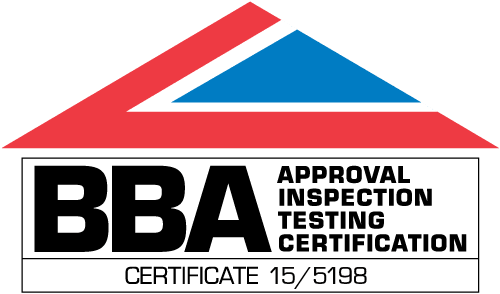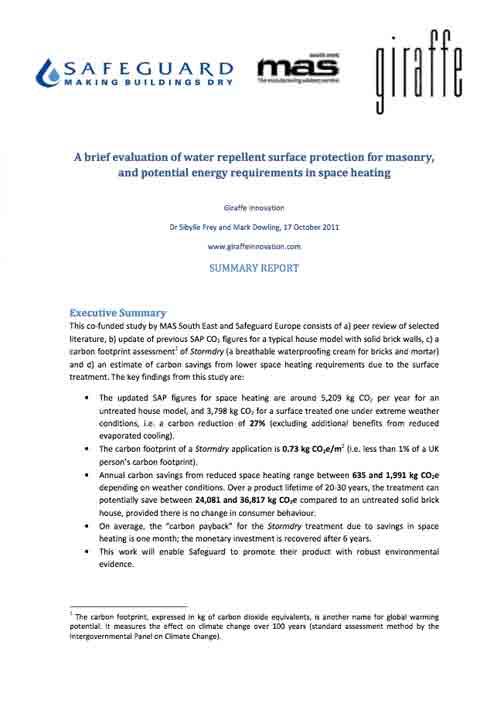Report: Giraffe Innovation - Energy Saving Analysis
This was a study and analysis of the environmental impact reduction and possible money savings available to a home owner when using Stormdry, performed by Giraffe Innovation Ltd, in 2011.
Report Aims
Giraffe Innovation is a leading environmental management consultancy. They consult with government, commercial and public sector organisations, to help reduce their environmental impact, costs and operating inefficiency. They were asked by both the Manufacturing Advisory Service and Safeguard Europe to assess the environmental impact of Stormdry.
Report Method
Giraffe’s assessment included a peer-review of selected literature from previous research on both Stormdry and similar products, including:
- Safeguard Laboratory report no.5 - Feasibility study on heat loss savings from the treatment of masonry with water repellents.
- Safeguard Laboratory report no. 18 - Estimates of energy savings with Stormdry.
- Safeguard Laboratory report no. 42 - Green deal - call for evidence.
- Vemund Årskog, Sverre Fossdal, Odd E. Gjørv (2003) - Methodology and data for calculation of LCE (Life Cycle Ecology) in repair planning.
- University of Portsmouth (2011) - Brick and Mortar Treatment by Cream Emulsion for Improved Water Repellence and Thermal Insulation.
- Other research commissioned on behalf of Safeguard.
All CO2 figures quoted from here onwards are drawn from the above tests/reports and the, then up to date, 2011 DEFRA emission factors for gas and electricity.
Using conclusions drawn from analysis of these studies, Giraffe Innovation were able to calculate the carbon footprint of a 108m² application of Stormdry to a house. They took CO2 figures for Stormdry production, delivery, contractor commute, preparation, application and waste disposal into account. The amount of total CO2 emitted from the start of production till the disposal of waste after application was then compared to alternative heat saving measures.
A scientifically estimated assessment of how much heating system carbon emissions could be reduced, as a result of Stormdry application, was then produced. This was based on the CO2e output of an average house, comparing the heating system emissions of both an untreated and Stormdry treated property, over the 30 year life time of the product. This part of the assessment produced two results, taking into account both dry weather and wet weather conditions.
Giraffe Innovation then delved deeper into the figures to review a previous 20 year cost/benefit analysis, by Safeguard Europe, on the cost of application versus the potential money that could be saved on heating bills.
Conclusions
After the peer review and first analysis of the general carbon foot print of Stormdry, from production through to application and disposal of waste, it was concluded that Stormdry has a foot print of 0.73 kg CO2e per m² of treated wall. To put this figure into context, it is roughly 30% less CO2 per square meter than Rockwool insulation, which has a foot print of 1.05 kg CO2e per m². It is also about 94% less than a standard foam insulation, which has a foot print of 13.7 kg CO2e per m². As a comparison, a similar assessment on a single 800g loaf of bread yields a foot print of 1.3 kg CO2e.
The carbon reduction estimate produced two separate results, one for the continuous wet weather and another for continuous dry weather. In continuous wet weather, a house treated with Stormdry will emit approximately 27% less kg of CO2e to maintain the same internal temperature as an untreated property. This is due to the water proof properties of Stormdry, not allowing the wall to become saturated and become colder. Even in dry weather, a Stormdry treated house will only have to emit around 9% less kg of CO2e than an untreated property to maintain the same internal temperature.
Taking the above figures into account, and the carbon footprint of Stormdry as a whole, Giraffe Innovation calculated that it would take only 1 month for the “carbon debt” of a 108m² application to be repaid. Depending on the weather, a house of this size stands to save between 24,081 and 36,817 kg CO2e compared to a similar untreated house.
The step in the assessment was a review of a previous cost/benefit analysis on the initial cost of applying Stormdry and the possible savings that could be made on heating bills. The figures show that, assuming an application cost of £500, a Stormdry treatment could pay for itself in heating bill savings within 6 years. On the house modelled it showed that, compared to an untreated house, a home owner could possible save over £1400 on heating bills, during a 20 year period. Giraffe Innovation found these figures to be consistent with their own results.


